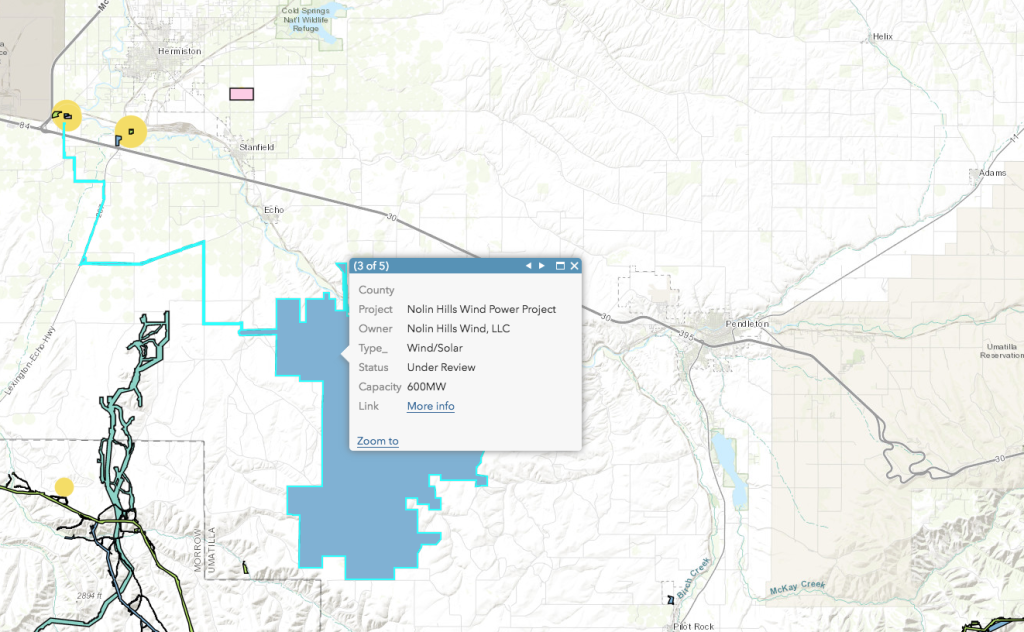Umatilla County’s Nolin Hills Wind Power Project receives approval
Published 3:00 pm Wednesday, August 2, 2023
PENDLETON — The largest wind project yet in Umatilla County has received its site certificate from the Oregon Energy Facility Siting Council.
Trending
The council at its public meeting on Wednesday, July 19, at the Oxford Inn Suites conference room in Pendleton voted to approve the certificate for the Nolin Hills Wind Power Project, the Edmonton, Alberta-based Capital Power’s proposed 48,196-acre wind and solar generation facility in Umatilla County.
“It’s a key milestone for us and we are really excited to watch the project come to fruition,” said Matt Martin, the Capital Power project manager overseeing Nolin Hills.
Nolin Hills has been 13 years in the works and is slated to feature a nominal generating capacity of 600 megawatts and up to 373 MW of average energy, with 340 megawatts coming from up to 112 wind turbines and 260 megawatts from up to 1,900 acres of solar panels. The company reported its target for the number of turbines is 92.
Trending
It will be south of Interstate 84 on private land zoned for exclusive farm use approximately 4 miles south of Echo and 10 miles west of Pendleton.
The biggest wind project yet in the county will interconnect with either the Umatilla Electric Cooperative or Bonneville Power Administration. Capital Power has yet to reach an agreement with either.
In addition to the power generation facilities, the project would build a battery energy storage system, two 230-kilovolt transmission lines, two substations, an electrical collection system, operations and maintenance building, access roads and up to three meteorological towers. Capital Power estimated the project’s cost at more than $1 billion.
Though Nolin Hills will be the first wind generation facility in the Hermiston area, it will join other recent additions such as Constellation Energy’s Echo Wind Project and Portland General Electric’s Wheatridge Renewable Energy Facility near Lexington in Morrow County, as well as the other wind projects throughout the Columbia River Gorge that take advantage of the region’s wind activity.
Controversy
Umatilla County Board of Commissioners Dan Dorran, Cindy Timmons and John Shafer were present for the decision in Pendleton. The approval news came as a disappointment to the county board, which sponsored a contested case against the project on the grounds it violated the Umatilla County Development Code.
The code requires a 2-mile setback of wind turbines from residences. Martin said the closest residences are 1.25 miles from the project site. Dorran said at the beginning there were 22 within 2 miles. Some landowners granted exemptions to Capital Power, drawing the count down to eight. Dorran said none of the remaining landowners raised personal objection to the under-2-mile siting.
Instead, Dorran said objections came from the Blue Mountain Alliance, a group based in Milton-Freewater that fought for the setback code when its community was confronted with the Chopin Wind Project.
“Our council put together what I thought was a really strong argument for the objection,” Dorran said.
The EFSC determined it was under no requirement to enforce the local provision according to state law, because the project otherwise complies with statewide planning goals, Dorran explained.
Martin said that even at 1.25 miles, this is a larger setback than Capital Power has encountered in the siting of any of its other wind projects.
“We have a number of projects all around North America where half a mile is the standard,” he said. “A mile and a quarter we view as substantial.”
He noted the proposed project complies with Oregon nuisance laws among others.
“We feel (1.25 miles) is sufficient and a good fit for the community,” Martin said. “The landowners have over 40,000 acres that will allow us to space out our facilities efficiently to fit into the surroundings.”
“I am 100% of the feeling that local land use laws and land use planning should really be observed and respected,” Dorran said, “and I think a one-size-fits-all is extremely dangerous.”
The county board does have the opportunity to appeal the decision for a third time, though the three commissioners are trying to decide if they want to incur the heavy expense it would take to appeal to the state supreme court, especially in light of the quickly evolving legislative landscape surrounding renewable energy projects, which might nullify a successful appeal.
Regardless of if he and his fellow commissioners decide to appeal again, Dorran has participated in some 60 hours of legislative work sessions related to two 2023 Oregon House bills, 3181 and 3179, which are intended to address land use planning and land use obligation issues relating to, for example, exclusive farm work zones, as well as the oversight powers counties have over proposed projects.
Dorran said there has been talk of granting “siting superpowers” to the governor of Oregon to fast-track renewable energy projects and bypass land use regulations and standards “with a stroke of the pen.” The governor has those powers now for semiconductor projects.
Benefits to the community
Nolin Hills will add generating capacity to the at-capacity regional grid. Increasing energy demands and aggressive carbon-free energy and greenhouse gas emission reduction/carbon-free goals in Oregon and Washington are driving the shift toward renewables, attracting investment in the region.
It’s not without benefit to the local communities that surround these projects either. Dorran said even if Capital Power were to pursue tax breaks or delayed tax benefits, it still would be obligated to pay taxes toward school districts and fire districts among others.
Another is the community service fee — annual funding that would come from Nolin Hills to the county, which would distribute the revenue to the affected community.
“Small towns in Umatilla County have benefited greatly from some of the other wind projects around the county,” Dorran said. “The fees have done everything from putting new windows in schools, paved a road in one community, funded new signage in another community and helped with a swimming pool in another. In short, a lot of projects in communities that would never have that revenue to spend on those projects.”
Dorran also said a lot of residents are happy the Nolin Hills Wind Power Project is going forward.
“The feelings in Umatilla County are not monolithic by any means,” he said. “There’s a contingent that’s very much against renewables and there’s a strong contingent of people who are very much for it.”
What happens next?
Capital Power Corp. is a publicly traded wholesale power generator established in 2009 on the foundation of Edmonton Power Corp., formerly Edmonton Power, which was originally incorporated in 1891 and later became the first municipal-owned electric utility in Canada.
Since becoming Capital Power, the company has set its sights on transitioning to a clean energy portfolio, with the goal of becoming net zero by 2045. The company got rid of its coal assets in 2023 and has been intensively acquiring and building renewable energy projects.
Capital Power operates 29 facilities that collectively generate 7,500 megawatts of electricity annually. The company employs some 800 people across North America.
Martin said Capital Power bought the Nolin Hills project in 2014 when it acquired Portland-based Element Power, the original developer of the project. Martin became project manager three years ago.
He said the EFSC site certificate approval isn’t the finish line, but the starting line for the project.
“I would not expect us to start construction before 2025,” he said, and the siting council is likely to issue its final order in August.
“There are many, many conditions the project will have to meet before the project can start,” he said. “A lot of site work, environmental studies, cultural studies and reconfirming that all the work from between 2017 to 2022 is still accurate, that nothing has changed. That’s going to take a good portion of 2024.”
He said Capital Power is planning to use U.S.-made solar panels from First Solar as well as U.S.-made wind turbines, though they have not settled on a company yet.
“One of the big changes from the inflation reduction act is a lot of incentive to buy American-made products,” he said.
After so many years in the making, Martin described what most excites him about the road ahead: “When you drive to the site and stand on top of the ridges and you feel the wind and the sun is shining and there is no one there, you realize it’s an ideal spot. … I’ve developed a lot of wind and solar across the U.S. and there is no better site, from my perspective.”
“I am 100% of the feeling that local land use laws and land use planning should really be observed and respected, and I think a one-size-fits-all is extremely dangerous.”
— Dan Dorran, Umatilla County commissioner
“There are many, many conditions the project will have to meet before the project can start.”
— Matt Martin, Nolin Hills Wind Power Project manager










